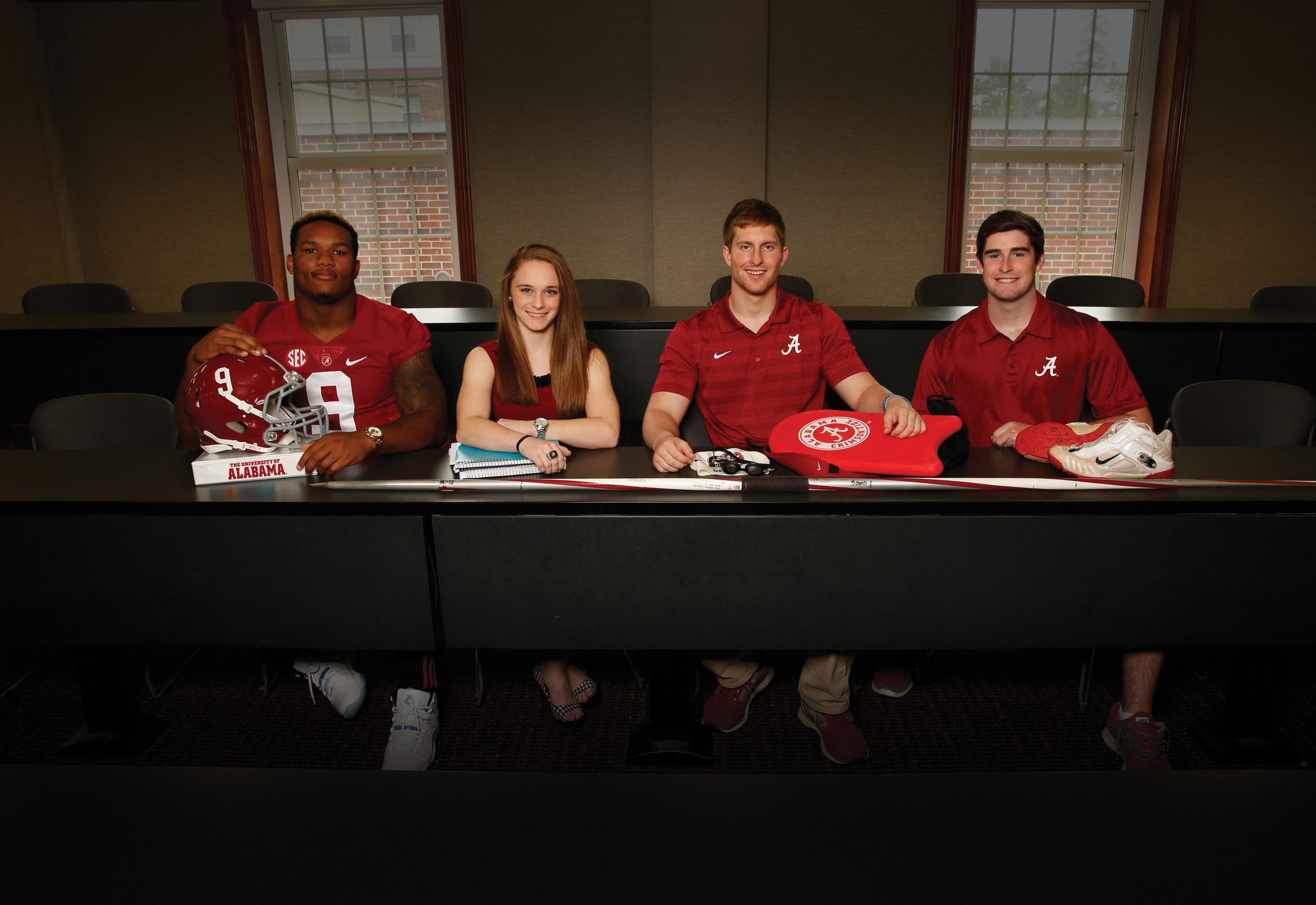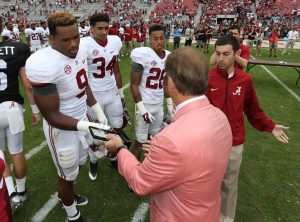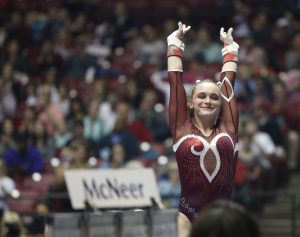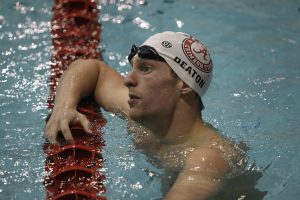
From left, student athletes Da’Shawn Hand, football; Keely McNeer, gymnastics; Phillip Deaton, swimming and diving; and Kevin Shannon, track and field, also study engineering.
During his senior year in high school, Da’Shawn Hand announced on ESPN he planned to attend The University of Alabama to study civil engineering.
“I love civil engineering, and they have that major,” said Hand while surrounded by the press and supporters at his school.
OK. That’s not the whole story.
Hand, a native of Virginia, was one of the most sough-after high school football players in the country at the time, and Nick Saban, head coach of the Crimson Tide football team, had offered Hand a scholarship to play on the team. After signing, Hand went on to be a contributor as a freshman during the Crimson Tide’s 2014 Southeastern Conference championship season.
But Hand, selected to be part of Woodbridge High School’s focused engineering curriculum, also made it clear he wanted to study engineering while playing NCAA Division-I football on an athletic scholarship. Dr. Charles L. Karr, dean of the College of Engineering, met with Hand during recruitment and told him it was possible to do both at Alabama.

“Dean Karr didn’t paint a false picture,” Hand said in an interview with Capstone Engineer. “He told me it was going to be hard, but if I did it, there would be a lot of reward.”
Hand is part of a growing number of Crimson Tide student athletes studying engineering or computer science in the College, something John Dever, associate athletics director for student services, attributes partly to Karr and others in the College working to help student-athletes succeed on and off the field.
“We’ve got more kids in engineering right now than in my 23 years here,” Dever said. “There is huge cooperation between athletics and engineering.”
Along with cooperation from the College, academic support for student athletes at UA has improved tremendously over the past decade or so, making time-consuming majors such as engineering less daunting, Dever said. There are 18 people on Dever’s staff and more than 100 tutors during a year. UA’s roughly 500 student-athletes carry an average 3.2 GPA.
“We want our students to major in whatever they want to study, and we don’t want them being frightened of the word engineering,” Dever said. “Being a student-athlete and getting an engineering degree says a lot about your discipline and time management because you’re doing a lot of things other students don’t have to do.”

Phillip Deaton knows all too well about balancing engineering coursework with athletic competition. Deaton, a student majoring in chemical engineering, was the captain of the men’s swimming and diving team his senior year. Since coming to the University, Deaton has been named to the SEC Academic Honor Roll and, recently, he was named an All-American Scholar by the College Swimming Coaches Association of America.
“I’ve never felt like swimming has hindered my academic performance; I think it just taught me better time management,” Deaton said. “When I was a freshman, there were senior engineering majors on the team who could lead me down the right path. Now I have the opportunity to do the same for other freshmen.”
Even before coming to the University, Deaton had been learning to balance his athletic activities with his academic aspirations. When he was still in middle school, he began swimming competitively with his local high school team in Madison, Alabama, ultimately helping the team to secure seven championships before graduating high school.
Like Deaton, gymnast Keely McNeer also began competing in high school, but back then she had no plans to become a college athlete. In high school, McNeer divided her time between rigorous advanced placement coursework and gymnastics.
“We’ve got more kids in engineering right now than in my 23 years here. There is huge cooperation between athletics and engineering.”
– John Dever, UA associate athletics director for student services
At the time, McNeer, a native of Madison, Mississippi, was on the path to compete in the Olympics, but during her senior year, she suffered several injuries. During this time, she devoted herself to her studies, eventually finishing high school a semester early and graduating with a high GPA. Because of her injuries, she doubted a return to gymnastics; nevertheless, she was contacted by several college recruiters while recovering. Just a few months later she enrolled at UA.
“My injuries made me question why I was doing (gymnastics),” McNeer said. “But the coaches here are really supportive. I’ve grown to love the sport again by being here.”
Now a sophomore in chemical engineering, McNeer wants to attend medical school after graduating.
“I can pretty much say that when I’m not (in the athletic center), I’m doing school work,” she said. “It’s very strenuous, but I don’t mind. I like having things to do.”
For Kevin Shannon, a junior in computer science from Vestavia, Alabama, who competes in the javelin throw for the track and field team, compartmentalization is the key to keeping his GPA above a 4.0 while still adhering to a rigorous athletics schedule.

“The javelin throw is a very technical event, and you expend a lot of mental energy,” Shannon said. “Before class starts, I try to get there five minutes early and read over all of my notes again so that my brain is already working.”
In the more high profile sport of football, Hand was the only football player his freshman year on scholarship with an engineering major, although there are several walk-on players on the team majoring in engineering. Dever said Hand’s choice in his studies will help future student-athletes see that UA helps them pursue academic and athletic goals.
“Having a high-profile kid like Da’Shawn helps,” he said. “It takes that one person to knock the lid off and show it can be done.”
For Hand, he’s heard from those who doubt he can do football and engineering at a high level, and he is not deterred. He’s ready for higher-level classes, and, while all-in with football, he hopes to one day manage his own civil engineering firm.
“Anyone who knows me knows I’m a hard worker, and I want to get the job done,” Hand said. “If you want to be successful, you’ll make sure you do what you got to do.”